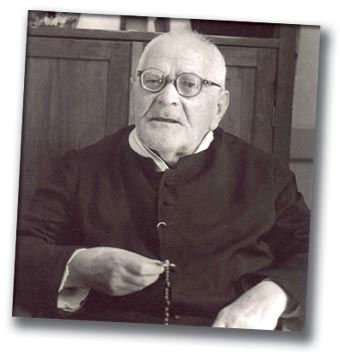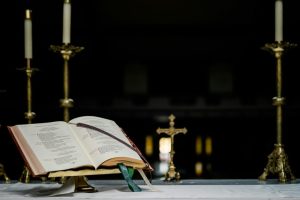The halls of Riuniti Hospital in Reggio Calabria were bustling that summer day with white-coated doctors and orderlies. The P.A. system blared as southern Italians waited in long lines for care. I had come for something else. I had come to see a medicine man about a miracle.
The previous fall, on Oct. 23, 2005, a cousin of mine, Padre Gaetano Catanoso, had been named a saint by Pope Benedict XVI in his first canonization ceremony. I was there with my family, along with tens of thousands of others. Now I was waiting outside the office of Dr. Giuseppe Bolignano, the hospital’s chief of infectious diseases. I was researching the life of my sanctified relative, and I had some questions for the doctor.
In January 2003 Dr. Bolignano had determined that Anna Pangallo, a comatose villager stricken with bacterial meningitis, could not be revived after days of antibiotics. The doctor advised the family to prepare for the 55-year-old woman’s death.
Instead, scores Anna’s loved ones began a round-the-clock prayer vigil in Reggio and her mountaintop village of Roccaforte del Greco. Their urgent prayers went only to the beatified Padre Gaetano, already credited by the Vatican with interceding for one healing miracle shortly after his death in 1963. When Anna rose from her coma after nine days, when a stunned Dr. Bolignano could not explain why she had recovered so thoroughly, when her medical records were fully scrutinized by Vatican officials, Padre Gaetano was credited with a second miracle, ensuring his eventual elevation to sainthood.
A few days prior to my hospital visit, I had traveled to Roccaforte to meet with Anna Pangallo in her tiny home. She was as devout and gracious as she was grateful.
She had revered Padre Gaetano since she was a little girl and attended an elementary school opened by the Sisters of St. Veronica of the Holy Face, an order my cousin founded in Reggio in 1934. Anna had no doubt that the prayers of her loved ones were indeed answered.
When I asked if she understood why she would receive such a blessing, she said humbly: “Sometimes I try to understand. I ask, why me? But I have no answers. It’s not for me to understand.”
I have been a newspaper journalist for 25 years. Asking questions is my stock in trade. Being skeptical is a professional requirement. Just because I am Catholic doesn’t smooth over the rough edges of my ever-present doubts. I have seen for myself many equally urgent prayers go unanswered.
Now I was awaiting Anna Pangallo’s doctor. I wanted to know, from a neutral source, how sick she really was. I wanted to know if her doctor believed her recovery was indeed miraculous. When Dr. Bolignano popped out of his office to tell me that he was running late, he stared at me hard before smiling.
“You look like a Catanoso! I am a Catanoso, too,” he said, shaking my hand. “My grandmother was a sister of the saint’s. I am his great-nephew.” Then he ducked back inside, leaving me staring at his door.
Instinctively, my initial reaction was not, Good Lord, what a wonderful coincidence! It was, Holy smoke, how do you say nepotism in Italian?
This all-important second miracle suddenly smelled of an inside job, with the relative pulling the strings not in heaven, but right here in the halls of Riuniti. My questions multiplied. How truly unresponsive had Anna Pangallo been to therapy? How hard would it be for her primary physician to fudge a few facts and make it look like her amazing recovery was unrelated to the medicine she was receiving, thus clearing a path to sainthood?
Dr. Bolignano’s office was narrow and uncluttered. His desk was stacked with medical journals. Two large posters of bacteria cell slides hung on the wall over his desk. There was a Padre Pio calendar, too, but no sign of Padre Gaetano. Settling in, the doctor led me through the case in question.
“Meningitis patients usually respond to the treatment of antibiotics we offer, but Anna Pangallo did not,” he told me. “There was no viable medical alternative. She was in terrible condition. I told the family the gravity of the situation and that the patient would not survive.”
At one point he was convinced she would die in a few hours. Instead, after nine days, she awoke from her coma. Like her family members and other doctors and nurses at the hospital, Dr. Bolignano was shocked.
“But I moved immediately to check for any type of damage that might have resulted from her very serious infection,” he said. “The X-rays we took prior to her waking up showed damage in her brain. We did more X-rays and found no lingering problems. The damage we documented while she was still comatose was no longer evident.”
He paused for a moment, then added, “As we worked through all the medical possibilities that might have led to her recovery and found none, we eventually gave in to the idea that there was another explanation, perhaps a religious explanation.”
I let that notion sink in. Earlier in my career I worked as a medical reporter. I interviewed doctors at the top medical centers in North Carolina about their research, about their patients, about the marvels of modern science and the limitations as well. Never had I heard an American doctor say that some patient who enjoyed an unexpected recovery may have received the assistance of supernatural powers. I pressed Dr. Bolignano on that point. He just shook his head.
“When you look at the radiology—the brain scans and the X-rays—all this showed serious damage and the potential for more damage prior to her coming out of her coma,” he said patiently. “Yet in one week, she moved from an extremely grave and life-threatening situation to one where she was essentially cured. Medical science cannot explain that because it happened so quickly.”
He went on to say that even if Anna had responded positively to the antibiotics, the onset of her meningitis should have left lasting damage to her hearing or brain. But it didn’t. She was healed. Completely and inexplicably. He was certain of that, which led me to wonder about his faith.
“Are you a devout Catholic?”
“Yes, of course,” he said.
“Do you believe in miracles?”
With a deep sigh that surprised me, he said, “I don’t know.” He shook his head slowly, gathering his thoughts. There was an earnestness to his voice that I found compelling. As he prepared to answer a question that was clearly charged with meaning for him, I found myself trusting him more.
“Miracles are simply incredible, and the fact that they are incredible makes them impossible to rationalize,” the doctor said. “There is a line that is incredible and unexplainable, and when you cross it, there is nothing else left but faith. If we’ve never experienced a miracle, we believe it through faith, and if we have experienced a miracle, we don’t try to explain it. We just accept it.
“In the end it is not my decision to make,” he went on. “The church defines this miracle, the Vatican. This huge commission, a part of the Vatican’s Consulta Medica [a five-person panel of doctors who work as independent Vatican consultants], came down here to check, to analyze, to thoroughly investigate the entire case of Anna Pangallo.”
The panel confirmed that there was no medical explanation for Anna’s recovery. Later, a panel of Vatican theologians declared the cure a miracle, which Pope John Paul II approved.
I understood the saint-naming process. Still I wondered: As a man of science with his advanced education, his medical journals, and his posters of cell biology, how did Dr. Bolignano reconcile the miraculous with the scientific?
“The dividing line is not clear; it depends on your background,” he said. “If your background and worldview is that of science primarily, you look at this case and say, ‘It is medically unexplainable’ and leave it at that. But if you look at it through the lens of your faith in God, then you don’t have a difficult time accepting it as a miracle.
“Please understand, there is no distinction between my faith and my scientific understandings. It’s a question of language and definition. To me, scientifically unexplainable matters can be understood through religious faith as miracles. That’s how the church defines it as well.”
Dr. Bolignano, without any prompting on my part, then turned the conversation to the man in the middle of all this, Padre Gaetano Catanoso.
“When I was a child, I went to church with the Veronican sisters. And yes, I knew Gaetano; he died when I was 17. I would go with my mother to see him almost every week. Uncle was so charismatic, so much fun, such a pleasure to be with.”
The pensive look Dr. Bolignano had been wearing changed to a sweet smile as the memories came to him. “When we knew we were going to see him the next day, we kids would be up at dawn, as if it were Christmas morning. That’s the way it was.”
For a while he got lost in the past. He shared one anecdote after another illustrating his great-uncle’s sweetness and faith. He had seen the impact Padre Gaetano had on those desperate for solace and spiritual guidance, including his parishioners, his nuns, and especially his relatives.
“This is the charisma of a singular and special person,” Dr. Bolignano told me. “This is not a person you will see again in your lifetime.”
The more he talked, the more I looked at his face and his eyes, the more he looked familiar—like family. His pride in being a Catanoso was palpable, and his tender love for his great-uncle was warm and real. I thought how nice would it be to just stop there, thank this busy doctor for his precious time, and be on my way.
But I couldn’t. When it came to Anna Pangallo’s miracle, I had to know what he knew and when he knew it. I felt nervous as I mentally phrased the next set of questions, perhaps even a bit unfaithful. But I edged in just the same, wanting to be more Larry King than Mike Wallace.
“Your love for Padre Gaetano is clear.”
“He is an example. That’s what sainthood is all about.”
“Did you attend the beatification in 1997?”
“Yes, of course.”
“Did you know one more miracle was needed for the canonization?”
“Yes, but it was immaterial. To me, he was already a saint.”
“So the fact that Pope John Paul II beatified him didn’t elevate your view of your uncle?”
“No, not at all. To be honest, Padre Gaetano would not have been interested in the beatification and canonization. All this show and pageantry would not have interested him.”
I took a deep breath. I needed to be more direct but wondered how far I could push. Carefully I asked, “As you were treating Anna Pangallo, did you have it in the back of your head that Padre Gaetano, your uncle, needed another miracle for canonization?” I was prepared for him to show me the door, but instead he simply showed me a bit more of his heart.
“No, no, no,” he said softly, shaking his head. “I was unaware of the fact that there was this effort to pray to Padre Gaetano on her behalf. I only learned after she was released. When she was here, she was my patient, and I was taking care of her.
“I was happy she woke up and recovered, but I didn’t need for it to be a miracle. You see, the canonization is only proof that the saint is real to those who didn’t know him. Those who knew him, like me, knew already that he was a saint.”
I couldn’t argue with that, and I am certain Anna Pangallo wouldn’t either. Whether she was healed by powerful prayers or her body’s own mysterious ways is something I’m glad I don’t have to decide. But this much is clear: When she needed it the most, she was blessed to have two Catanosos in her life—one in heaven, the other at the hospital.
“All in the family” appeared in the November 2008 issue of U.S. Catholic (Vol. 73, No. 11, pages 32-34).














Add comment